Study on Dynamic and Static Mechanical Properties of Copper-Plated Steel-Fiber-Reinforced Self-Compacting Concrete
Abstract
:1. Introduction
2. Materials and Experimental Program
2.1. Raw Material
2.2. Mix Proportion
2.3. Processing of Concrete Specimen
2.4. Equipment and Principle
2.4.1. SHPB Test
2.4.2. Static Mechanical Test
3. Results and Discussion
3.1. Static Mechanical Test
3.1.1. Average Compressive Strength and Tensile Strength of CPSFRSCC with Different Volume Fractions of CPSF
3.1.2. Typical Failure Pattern of CPSFRSCC with Different Volume Fractions of CPSF in Static Compression and Tensile Test
3.2. Dynamic Tensile Experimental of CPSFRSC
3.2.1. Stress–Strain Curves
- Initial stage: In the initial stage of dynamic loading, the gap between the internal pores and the aggregate of the specimen is closed due to the loading of the stress wave transmitted along the direction of the bar, showing a slow strain hardening growth stage from the curve.
- Elastic stage: The elastic stage of curve occurs after the initial stage. Similar to other concrete materials, in this stage, the curve shows an approximately linear growth relationship with the accumulation of strain. Some studies show that concrete materials usually reach the elastic stage limit when stress reaches 75% of the peak stress [45], which also applies to the curve of CPSFRSCC.
- Yield stage: With the continuous loading of impact loading and the accumulation of strain, the curve shows a trend in strain softening behavior and a nonlinear growth relationship with the accumulation of strain. The gap between the internal apertures and the aggregate begins to develop continuously, and the specimen shows the characteristics of plastic deformation.
- Failure stage: With the continuous development of the apertures in the specimen and the gap between the aggregates, different degrees of cracks and fracture surfaces are produced. With the further loading of impact loading, the continuous development and interconnection of cracks and fracture surfaces lead to the fragmentation of the specimen, and stress reaches the peak on the curve. However, the specimen after failure still has a certain bearing capacity in a short time, which can be seen from the slow decline after the curve reaches the peak rather than the cliff-like decline.
3.2.2. Dynamic Tensile Strength and DIF of CPSFRSC
3.2.3. Failure Process
3.3. Numerical Simulation of Dynamic Failure Characteristics of CPSFRSC
3.3.1. Modeling
3.3.2. Constitutive Model and Material Parameters
3.3.3. Randomly Distributed of Fiber
3.3.4. Results and Verification
4. Conclusions
- The static compressive strength and static tensile strength of CPSFRSCC can be improved by adding CPSF, and the improvement in static tensile strength is more obvious. The tensile strength of CPSFRSCC increases with the increase in the volume fraction of CPSF and reaches its maximum value when the volume fraction of CPSF is 3%.
- The dynamic tensile strength of CPSFRSCC increases first and then decreases with the increase in the volume fraction of CPSF, reaching its maximum value when the volume fraction of CPSF is 2%. When the volume fraction of CPSF exceeds 2%, the dynamic tensile strength decreased, but the peak tensile strength remains higher than that of conventional SCC. In addition, with the increase in strain rate, CPSFRSCC shows an obvious strain rate effect.
- The results of numerical simulation show that CPSF has a significant effect on the failure morphology of SCC. The crack width decreases slightly, and the specimen is almost completely broken when 0.5% and 1% of CPSF are mixed; the crack width decreases obviously and the width of both ends of the crack is greater than the width of the crack near the center of the disk specimen, and the specimen is not completely broken when 1.5%, 2%, 2.5%, and 3% of CPSF are mixed.
Author Contributions
Funding
Institutional Review Board Statement
Informed Consent Statement
Data Availability Statement
Conflicts of Interest
References
- Gupta, N.; Siddique, R.; Belarbi, R. Sustainable and Greener Self-Compacting Concrete incorporating Industrial By-Products: A Review. J. Cleaner. Prod. 2021, 284, 124803. [Google Scholar] [CrossRef]
- Revilla-Cuesta, V.; Skaf, M.; Faleschini, F.; Manuel Manso, J.; Ortega-Lopez, V. Self-compacting concrete manufactured with recycled concrete aggregate: An overview. J. Cleaner. Prod. 2020, 262, 121362. [Google Scholar] [CrossRef]
- Yu, Z.; Tang, R.; Cao, P.; Huang, Q.; Xie, X.; Shi, F. Multi-axial test and failure criterion analysis on self-compacting lightweight aggregate concrete. Constr. Build. Mater. 2019, 215, 786–798. [Google Scholar] [CrossRef]
- Asteris, P.G.; Kolovos, K.G. Self-compacting concrete strength prediction using surrogate models. Neural. Comput. Appl. 2019, 31, 409–424. [Google Scholar] [CrossRef]
- Nasr, D.; Behforouz, B.; Borujeni, P.R.; Borujeni, S.A.; Zehtab, B. Effect of nano-silica on mechanical properties and durability of self-compacting mortar containing natural zeolite: Experimental investigations and artificial neural network modeling. Constr. Build. Mater. 2019, 229, 116888. [Google Scholar] [CrossRef]
- Zhang, C.; Gholipour, G.; Mousavi, A.A. Nonlinear dynamic behavior of simply-supported RC beams subjected to combined impact-blast loading. Eng. Struct. 2019, 181, 124–142. [Google Scholar] [CrossRef]
- Siddika, A.; Al Mamun, M.A.; Alyousef, R.; Amran, Y.H.M. Strengthening of reinforced concrete beams by using fiber-reinforced polymer composites: A review. J. Build. Eng. 2019, 25, 100798. [Google Scholar] [CrossRef]
- Pająk, M.; Baranowski, P.; Janiszewski, J.; Kucewicz, M.; Mazurkiewicz, Ł.; Łaźniewska-Piekarczyk, B. Experimental testing and 3D meso-scale numerical simulations of SCC subjected to high compression strain rates. Constr. Build. Mater. 2021, 302, 124379. [Google Scholar] [CrossRef]
- Zhang, J.; Chen, C.; Li, X.; Chen, X.; Zhang, Y. Dynamic Mechanical Properties of Self-Compacting Rubberized Concrete under High Strain Rates. J. Mater. Civ. Eng. 2021, 33, 04020458. [Google Scholar] [CrossRef]
- Koutas, L.N.; Tetta, Z.; Bournas, D.A.; Triantafillou, T.C. Strengthening of Concrete Structures with Textile Reinforced Mortars: State-of-the-Art Review. J. Compos. Constr. 2019, 23, 03118001. [Google Scholar] [CrossRef]
- Wang, D.; Ju, Y.; Shen, H.; Xu, L. Mechanical properties of high performance concrete reinforced with basalt fiber and polypropylene fiber. Constr. Build. Mater. 2019, 197, 464–473. [Google Scholar] [CrossRef]
- Rajak, D.K.; Pagar, D.D.; Menezes, P.L.; Linul, E. Fiber-Reinforced Polymer Composites: Manufacturing, Properties, and Applications. Polymers 2019, 11, 1667. [Google Scholar] [CrossRef] [PubMed]
- Sabri, I.; Faleh, S.; Mahdi, M. Effects of Fiber Type and Shape on the Shear Behavior of Reinforced Concrete Corbels without Hoop Re-bars. Civil. Eng. J. 2022, 8, 519–530. [Google Scholar] [CrossRef]
- Ahmad, J.; Gonzalez-Lezcano, R.A.; Majdi, A.; Ben Kahla, N.; Deifalla, A.F.; El-Shorbagy, M.A. Glass Fibers Reinforced Concrete: Overview on Mechanical, Durability and Microstructure Analysis. Materials 2022, 15, 5111. [Google Scholar] [CrossRef]
- Qin, Y.; Zhang, X.; Chai, J.; Xu, Z.; Li, S. Experimental study of compressive behavior of polypropylene-fiber-reinforced and polypropylene-fiber-fabric-reinforced concrete. Constr. Build. Mater. 2019, 194, 216–225. [Google Scholar] [CrossRef]
- Patchen, A.; Young, S.; Penumadu, D. An Investigation of Mechanical Properties of Recycled Carbon Fiber Reinforced Ultra-High-Performance Concrete. Materials 2023, 16, 314. [Google Scholar] [CrossRef]
- Dvorkin, L.; Bordiuzhenko, O.; Tekle, B.H.; Ribakov, Y. A Method for the Design of Concrete with Combined Steel and Basalt Fiber. Appl. Sci. 2021, 11, 8850. [Google Scholar] [CrossRef]
- Ichim, M.; Stelea, L.; Filip, I.; Lisa, G.; Muresan, E.I. Thermal and Mechanical Characterization of Coir Fibre-Reinforced Polypropylene Biocomposites. Crystals 2022, 12, 1249. [Google Scholar] [CrossRef]
- Draganic, H.; Gazic, G.; Lukic, S.; Jelec, M. Experimental investigation on blast load resistance of reinforced concrete slabs retrofitted with epoxy resin impregnated glass fiber textiles. Compos. Struct. 2021, 274, 114349. [Google Scholar] [CrossRef]
- Gong, J.; Ma, Y.; Fu, J.; Hu, J.; Ouyang, X.; Zhang, Z.; Wang, H. Utilization of fibers in ultra-high performance concrete: A review. Compos. Part B Eng. 2022, 241, 109995. [Google Scholar] [CrossRef]
- Vijayan, D.S.; Sivasuriyan, A.; Parthiban, D.; Jakimiuk, A.; Bayat, H.; Podlasek, A.; Vaverkova, M.D.; Koda, E. A Comprehensive Analysis of the Use of SFRC in Structures and Its Current State of Development in the Construction Industry. Materials 2022, 15, 7012. [Google Scholar] [CrossRef] [PubMed]
- Liew, K.M.; Akbar, A. The recent progress of recycled steel fiber reinforced concrete. Constr. Build. Mater. 2020, 232, 117232. [Google Scholar] [CrossRef]
- Khan, M.; Cao, M.; Chu, S.H.; Ali, M. Properties of hybrid steel-basalt fiber reinforced concrete exposed to different surrounding conditions. Constr. Build. Mater. 2022, 322, 126340. [Google Scholar] [CrossRef]
- Hua, J.; Yang, Z.; Xue, X.; Huang, L.; Wang, N.; Chen, Z. Bond properties of bimetallic steel bar in seawater sea-sand concrete at different ages. Constr. Build. Mater. 2022, 323, 126539. [Google Scholar] [CrossRef]
- Aisheh, Y.I.A.; Atrushi, D.S.; Akeed, M.H.; Qaidi, S.; Tayeh, B.A. Influence of steel fibers and microsilica on the mechanical properties of ultra-high-performance geopolymer concrete (UHP-GPC). Case Stud. Constr. Mater. 2022, 17, e01245. [Google Scholar] [CrossRef]
- Qaidi, S.; Najm, H.M.; Abed, S.M.; Ozlahc, Y.O.; Al Dughaishi, H.; Alosta, M.; Sabri, M.M.S.; Alkhatib, F.; Milad, A. Concrete Containing Waste Glass as an Environmentally Friendly Aggregate: A Review on Fresh and Mechanical Characteristics. Materials 2022, 15, 6222. [Google Scholar] [CrossRef]
- Ben Chaabene, W.; Flah, M.; Nehdi, M.L. Machine learning prediction of mechanical properties of concrete: Critical review. Constr. Build. Mater. 2020, 260, 119889. [Google Scholar] [CrossRef]
- Ren, X.; Ding, Y.; Liu, Q.; Chen, S.; Song, F. Effect of different volume fraction of steel fiber/graphite on thermal conductivity and compressive properties of concrete. Front. Mater. 2022, 9, 1003830. [Google Scholar] [CrossRef]
- Li, N.; Jin, Z.; Long, G.; Chen, L.; Fu, Q.; Yu, Y.; Zhang, X.; Xiong, C. Impact resistance of steel fiber-reinforced self-compacting concrete (SCC) at high strain rates. J. Build. Eng. 2021, 38, 102212. [Google Scholar] [CrossRef]
- Liao, L.; Zhao, J.; Zhang, F.; Li, S.; Wang, Z. Experimental study on compressive properties of SFRC under high strain rate with different fiber content and aspect ratio. Constr. Build. Mater. 2020, 261, 119906. [Google Scholar] [CrossRef]
- Zhao, M.; Zhang, B.; Shang, P.; Fu, Y.; Zhang, X.; Zhao, S. Complete Stress-Strain Curves of Self-Compacting Steel Fiber Reinforced Expanded-Shale Lightweight Concrete under Uniaxial Compression. Materials 2019, 12, 2979. [Google Scholar] [CrossRef]
- Aslani, F.; Hou, L.; Nejadi, S.; Sun, J.; Abbasi, S. Experimental analysis of fiber-reinforced recycled aggregate self-compacting concrete using waste recycled concrete aggregates, polypropylene, and steel fibers. Struct. Concr. 2019, 20, 1670–1683. [Google Scholar] [CrossRef]
- Chi, Y.; Yu, M.; Huang, L.; Xu, L. Finite element modeling of steel-polypropylene hybrid fiber reinforced concrete using modified concrete damaged plasticity. Eng. Struct. 2017, 148, 23–35. [Google Scholar] [CrossRef]
- Kim, S.; Choi, S.; Yoo, D.-Y. Surface modification of steel fibers using chemical solutions and their pullout behaviors from ultra-high-performance concrete. J. Build. Eng. 2020, 32, 101709. [Google Scholar] [CrossRef]
- Mandal, D.; Dutta, B.K.; Panigrahi, S.C. Influence of mechanical working on properties of aluminium base short steel fiber reinforced composites. J. Mater. Sci. 2007, 42, 8622–8628. [Google Scholar] [CrossRef]
- Oz, A.; Bayrak, B.; Kavaz, E.; Kaplan, G.; Celebi, O.; Alcan, H.G.; Aydin, A.C. The radiation shielding and microstructure properties of quartzic and metakaolin based geopolymer concrete. Constr. Build. Mater. 2022, 342, 127923. [Google Scholar] [CrossRef]
- Soufeiani, L.; Raman, S.N.; Bin Jumaat, M.Z.; Alengaram, U.J.; Ghadyani, G.; Mendis, P. Influences of the volume fraction and shape of steel fibers on fiber-reinforced concrete subjected to dynamic loading—A review. Eng. Struct. 2016, 124, 405–417. [Google Scholar] [CrossRef]
- Han, Z.; Li, D.; Li, X. Dynamic mechanical properties and wave propagation of composite rock-mortar specimens based on SHPB tests. Int. J. Min. Sci. Technol. 2022, 32, 793–806. [Google Scholar] [CrossRef]
- Wang, A.; Cao, S.; Yilmaz, E. Effect of height to diameter ratio on dynamic characteristics of cemented tailings backfills with fiber reinforcement through impact loading. Constr. Build. Mater. 2022, 322, 126448. [Google Scholar] [CrossRef]
- Chen, X.; Shao, Y.; Chen, C.; Xu, L. Statistical Analysis of Dynamic Splitting Tensile Strength of Concrete Using Different Types of Jaws. J. Mater. Civ. Eng. 2016, 28, 04016117. [Google Scholar] [CrossRef]
- Dai, F.; Huang, S.; Xia, K.; Tan, Z. Some Fundamental Issues in Dynamic Compression and Tension Tests of Rocks Using Split Hopkinson Pressure Bar. Rock. Mech. Rock. Eng. 2010, 43, 657–666. [Google Scholar] [CrossRef]
- Shi, B.; Xing, H.; Mu, C.; Li, J.; Xu, T.; Liu, W. Analysis of Optimal Loading Angle in Dynamic Flattened Brazilian Disc Splitting Test for Concrete. Appl. Sci. 2022, 12, 11834. [Google Scholar] [CrossRef]
- Zhao, K.; Yang, D.; Gong, C.; Zhuo, Y.; Wang, X.; Zhong, W. Evaluation of internal microcrack evolution in red sandstone based on time-frequency domain characteristics of acoustic emission signals. Constr. Build. Mater. 2020, 260, 120435. [Google Scholar] [CrossRef]
- Xu, L.; Wu, F.; Chi, Y.; Cheng, P.; Zeng, Y.; Chen, Q. Effects of coarse aggregate and steel fibre contents on mechanical properties of high performance concrete. Constr. Build. Mater. 2019, 206, 97–110. [Google Scholar] [CrossRef]
- Liu, W.; Xu, X.; Mu, C. Development of Damage Type Viscoelastic Ontological Model for Soft and Hard Materials under High-Strain-Rate Conditions. Appl. Sci. 2022, 12, 8407. [Google Scholar] [CrossRef]
- Madkour, H.; Maher, M.; Ali, O. Finite element analysis for interior slab-column connections reinforced with GFRP bars using damage plasticity model. J. Build. Eng. 2022, 48, 104013. [Google Scholar] [CrossRef]
- Fang, Z.; Zhou, H.; Lai, S.; Xie, Q. ABAQUS bond-slip element of reinforced concrete under cyclic loads. Eng. J. Wuhan Univ. 2014, 47, 527–531. (In Chinese) [Google Scholar]
- Fang, Z.; Zhou, H.; Lai, S.; Xie, Q. Choose of ABAQUS concrete stress-strain curve. Build. Struct. 2013, 43, 559–561. (In Chinese) [Google Scholar] [CrossRef]
- Lee, S.-H.; Abolmaali, A.; Shin, K.-J.; Lee, H.-D. ABAQUS modeling for post-tensioned reinforced concrete beams. J. Build. Eng. 2020, 30, 101273. [Google Scholar] [CrossRef]
- Senthil, K.; Iqbal, M.A.; Arindam, B.; Mittal, R.; Gupta, N.K. Ballistic resistance of 2024 aluminium plates against hemispherical, sphere and blunt nose projectiles. Thin Walled Struct. 2018, 126, 94–105. [Google Scholar] [CrossRef]
- Li, Y.; Li, Y. Evaluation of elastic properties of fiber reinforced concrete with homogenization theory and finite element simulation. Constr Build Mater. 2019, 200, 301–309. [Google Scholar] [CrossRef]
- Rong, Z.; Sun, W. Experimental and numerical investigation on the dynamic tensile behavior of ultra-high performance cement based composites. Constr. Build. Mater. 2012, 31, 168–173. [Google Scholar] [CrossRef]
- Wu, Z.; Cui, W.; Fan, L.; Liu, Q. Mesomechanism of the dynamic tensile fracture and fragmentation behaviour of concrete with heterogeneous mesostructure. Constr. Build. Mater. 2019, 217, 573–591. [Google Scholar] [CrossRef]
- Chen, Z.-Y.; Yang, J. Experimental Study on Dynamic Splitting Characteristics of Carbon Fiber Reinforced Concrete. Materials 2021, 14, 94. [Google Scholar] [CrossRef] [PubMed]
- Huang, C.; Chen, Y.; Wang, J.; Wang, Z.; Zhao, Q.; Zhu, L.; Wei, W.; Gao, Z. Study on dynamic compressive mechanical properties of freeze-thaw concrete. Constr. Build. Mater. 2022, 322, 126499. [Google Scholar] [CrossRef]

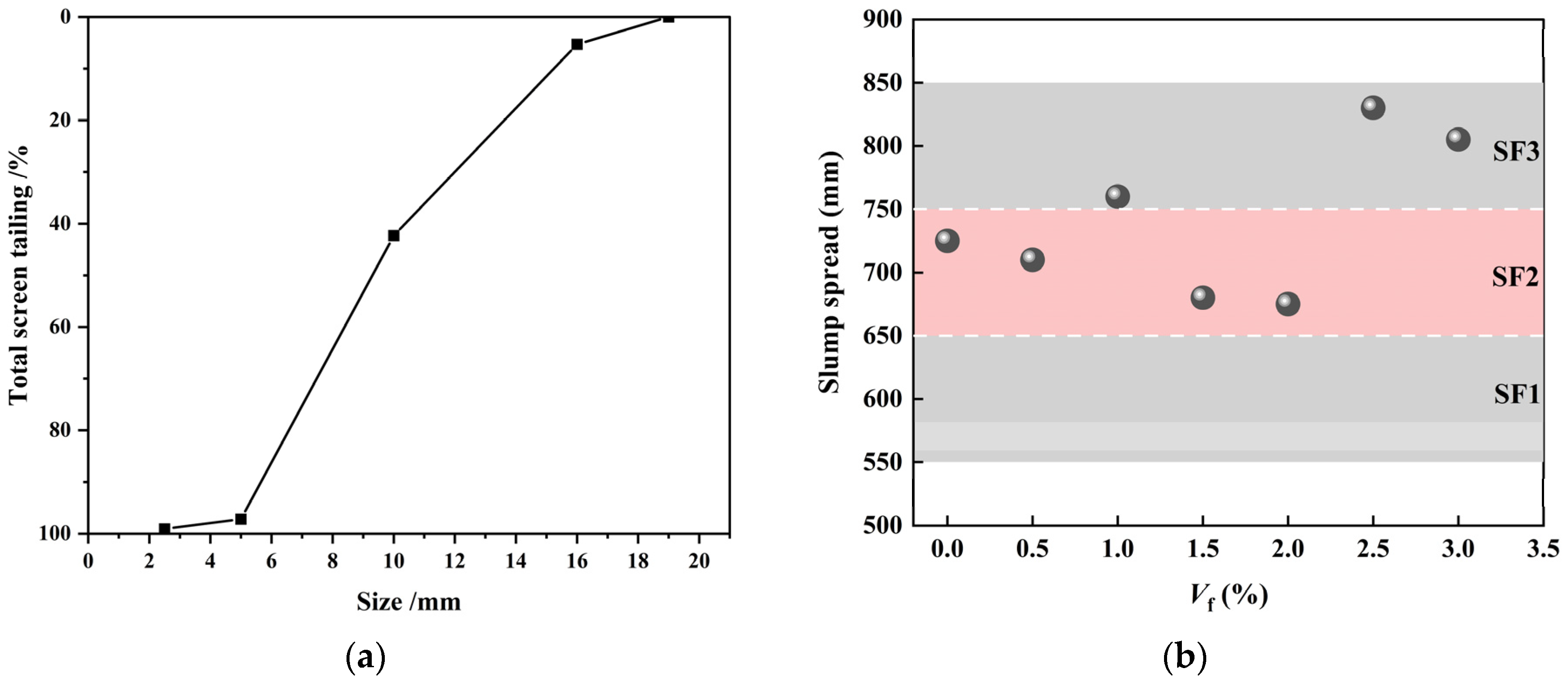
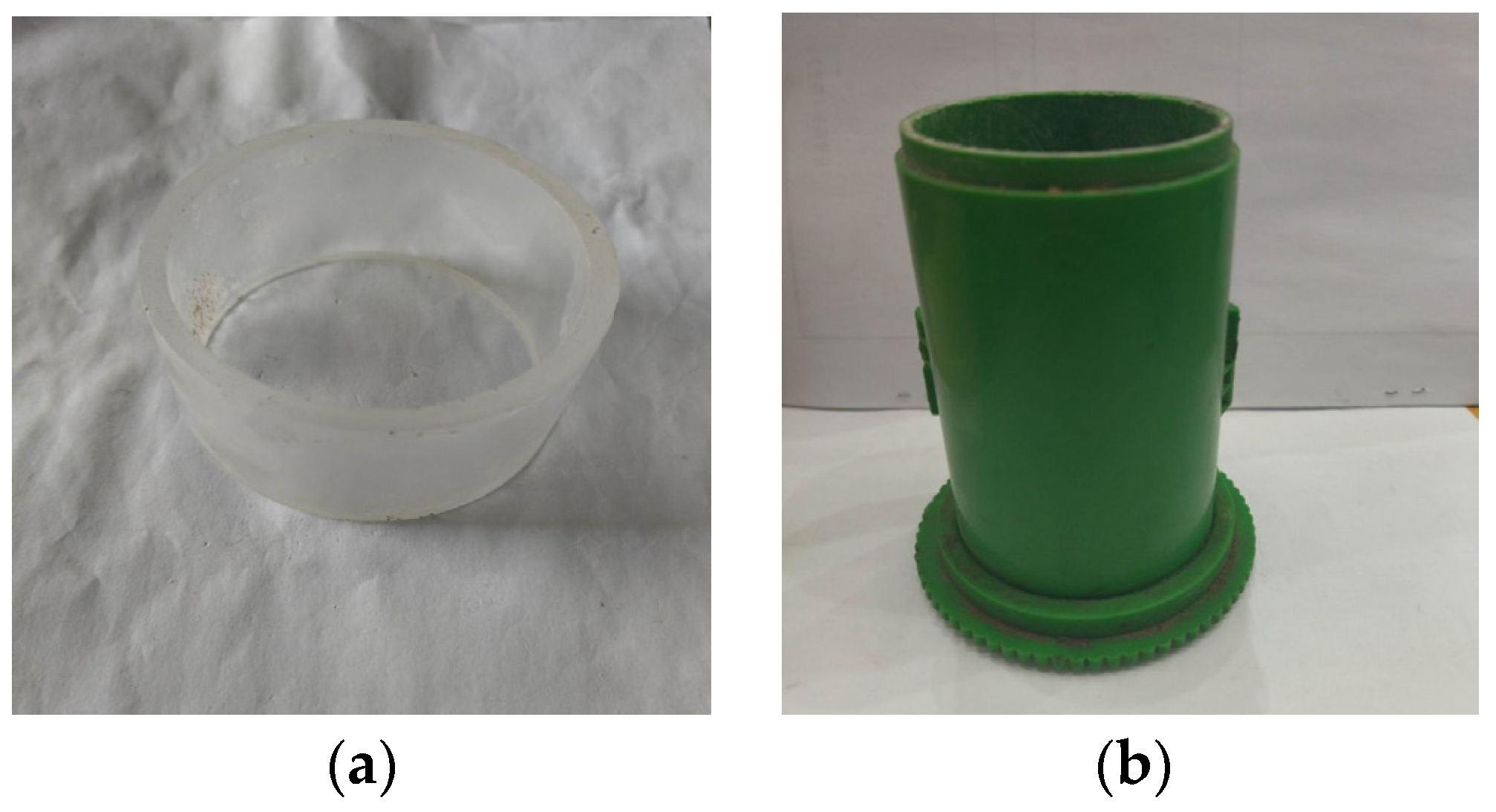
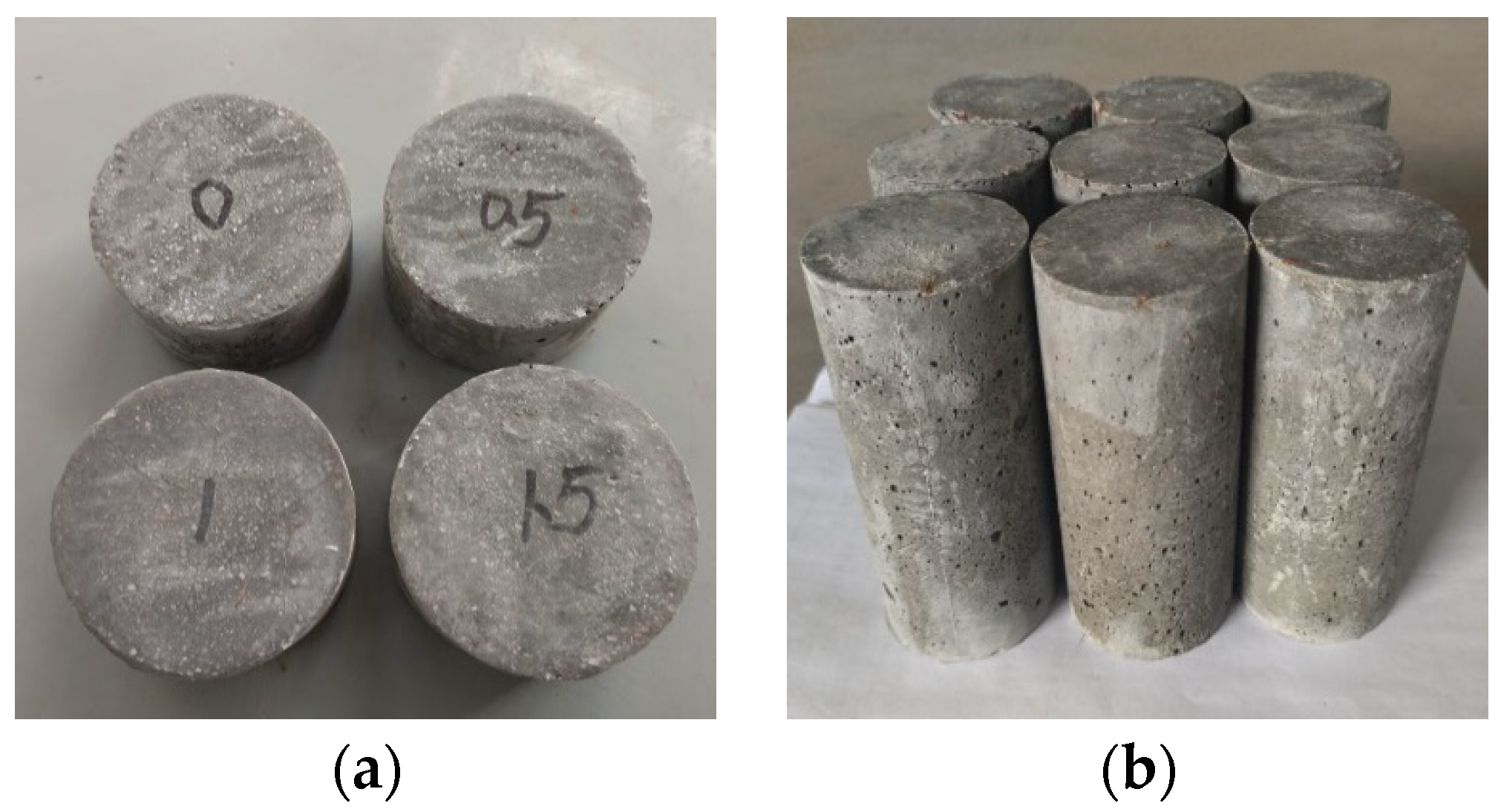


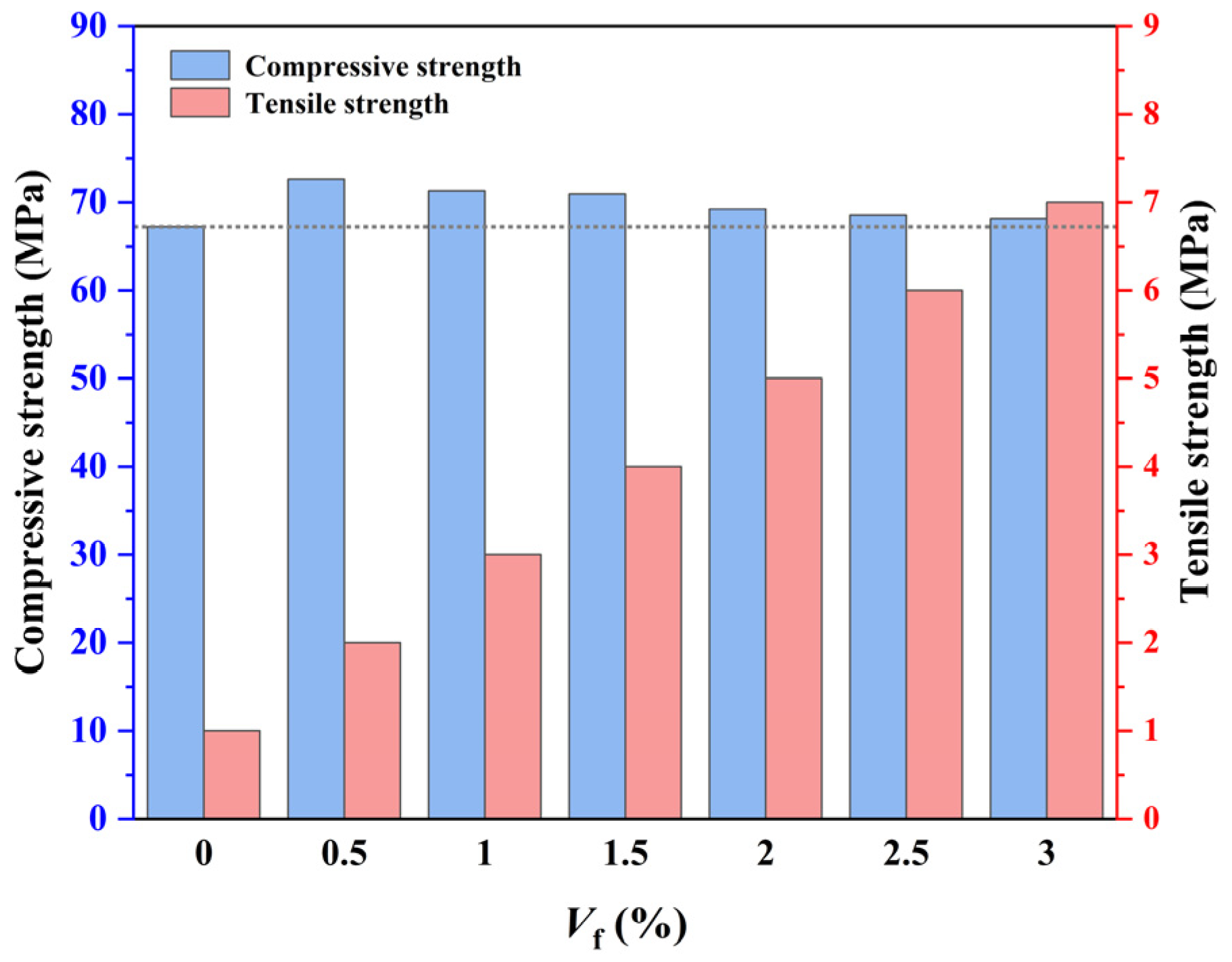
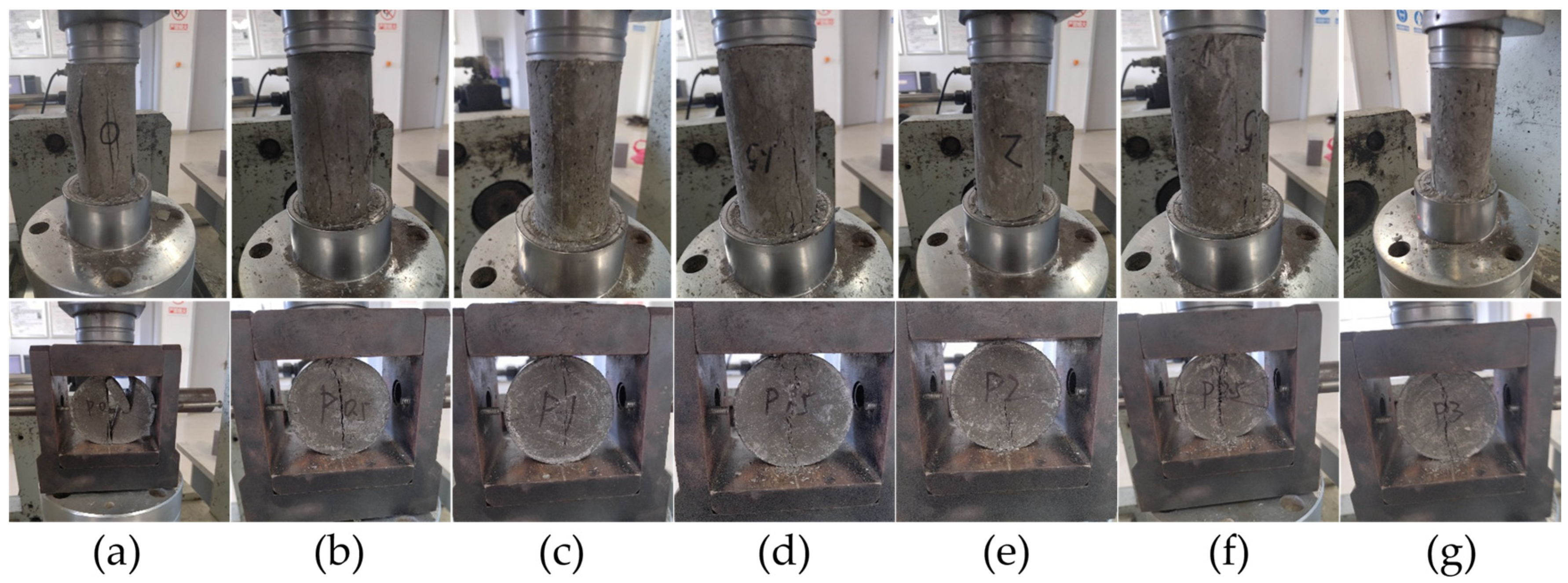
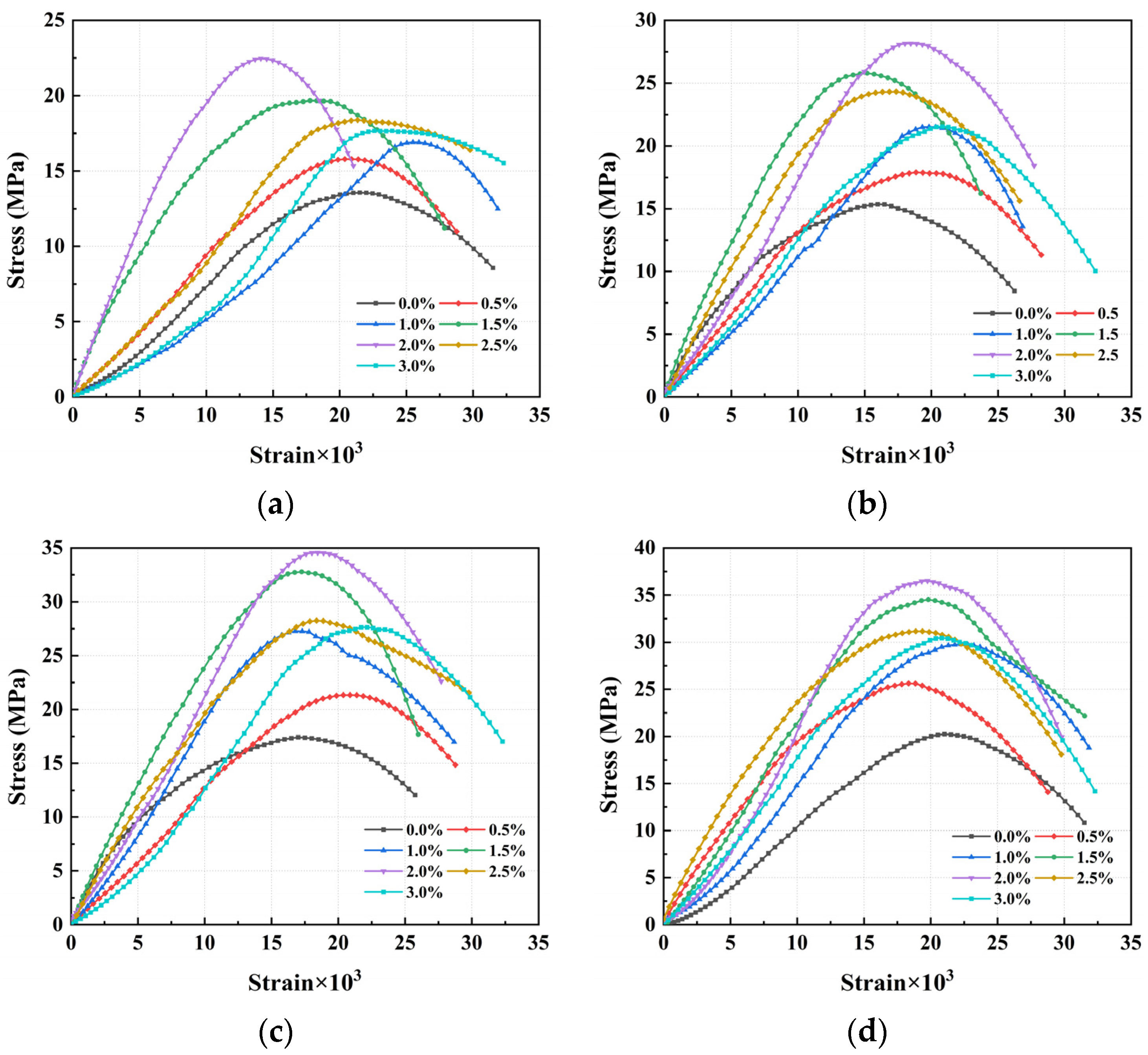
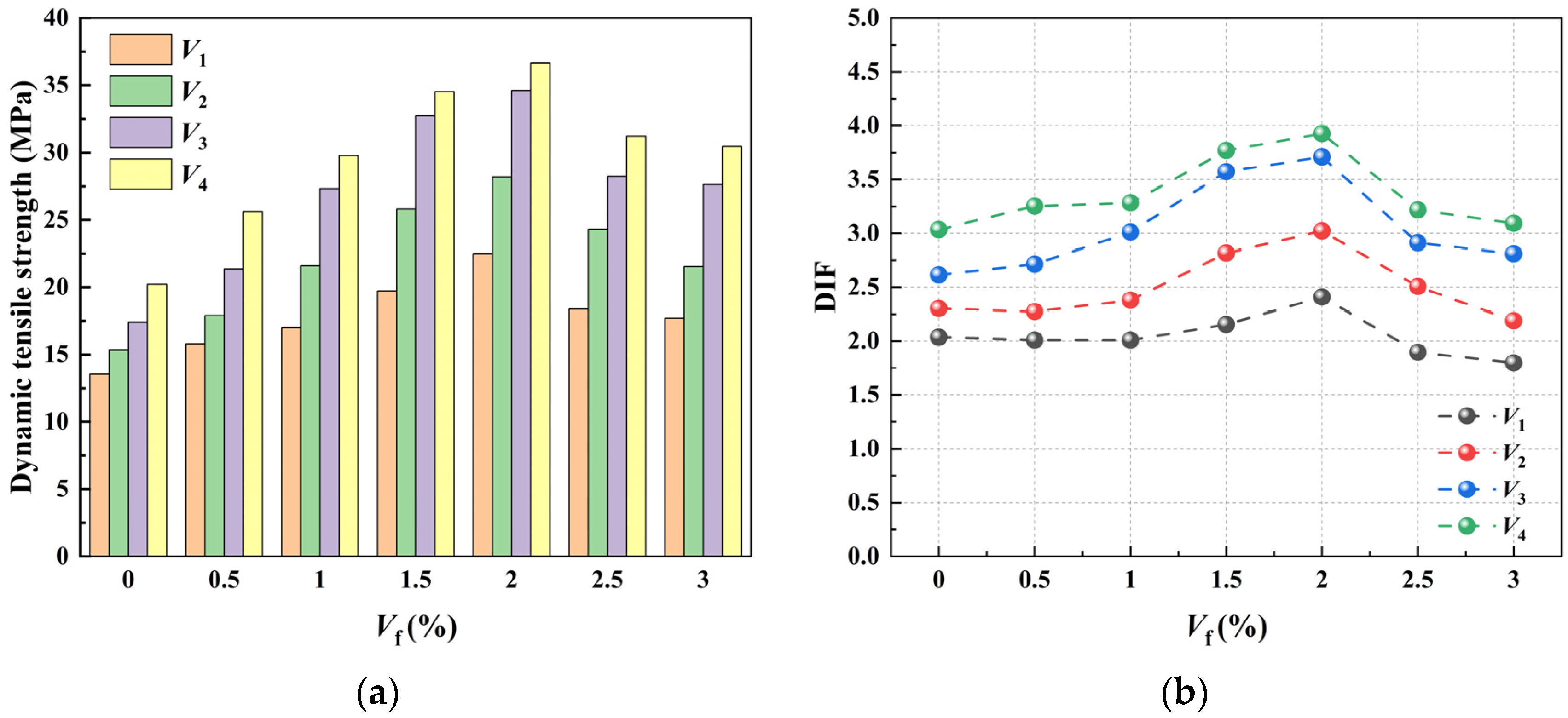
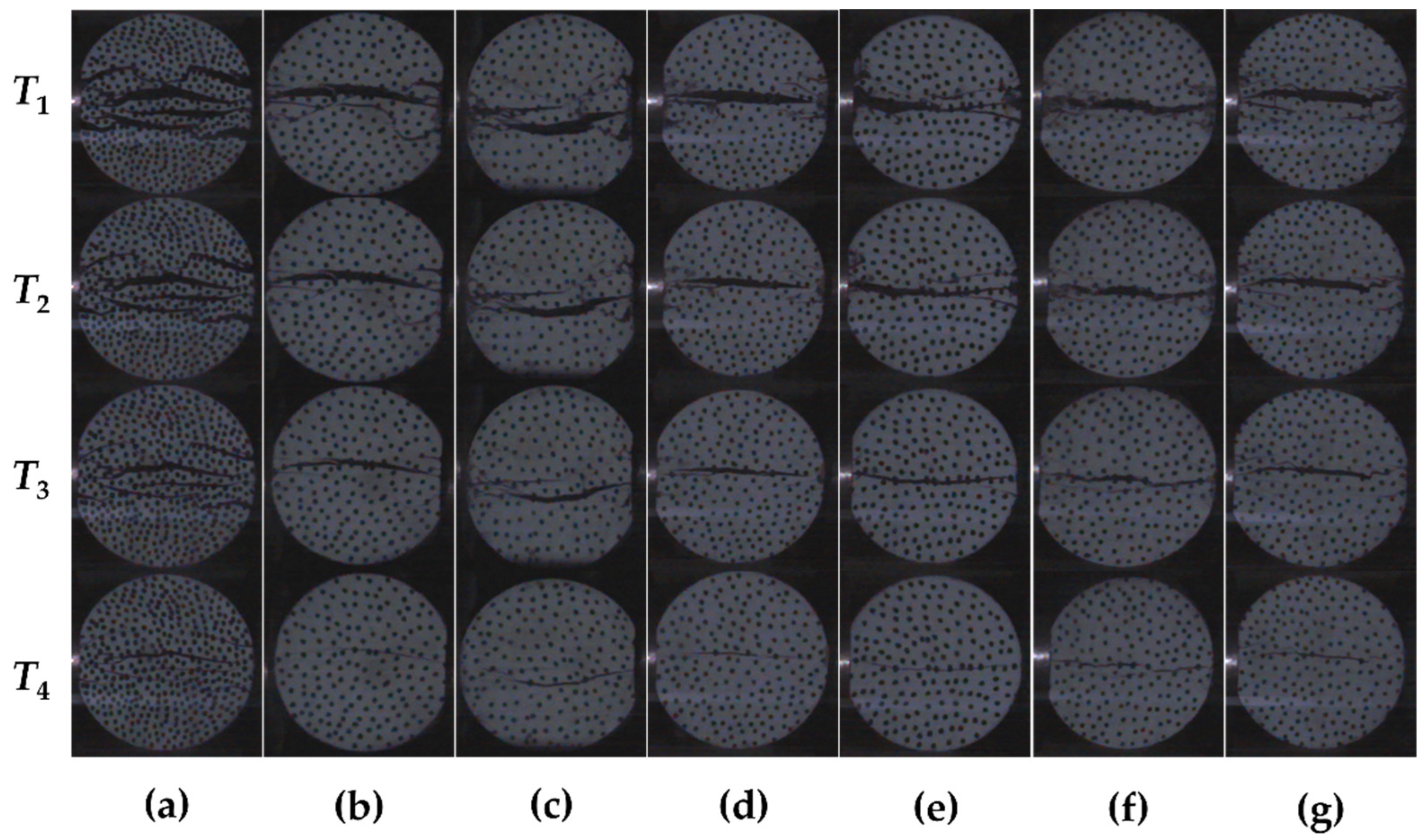
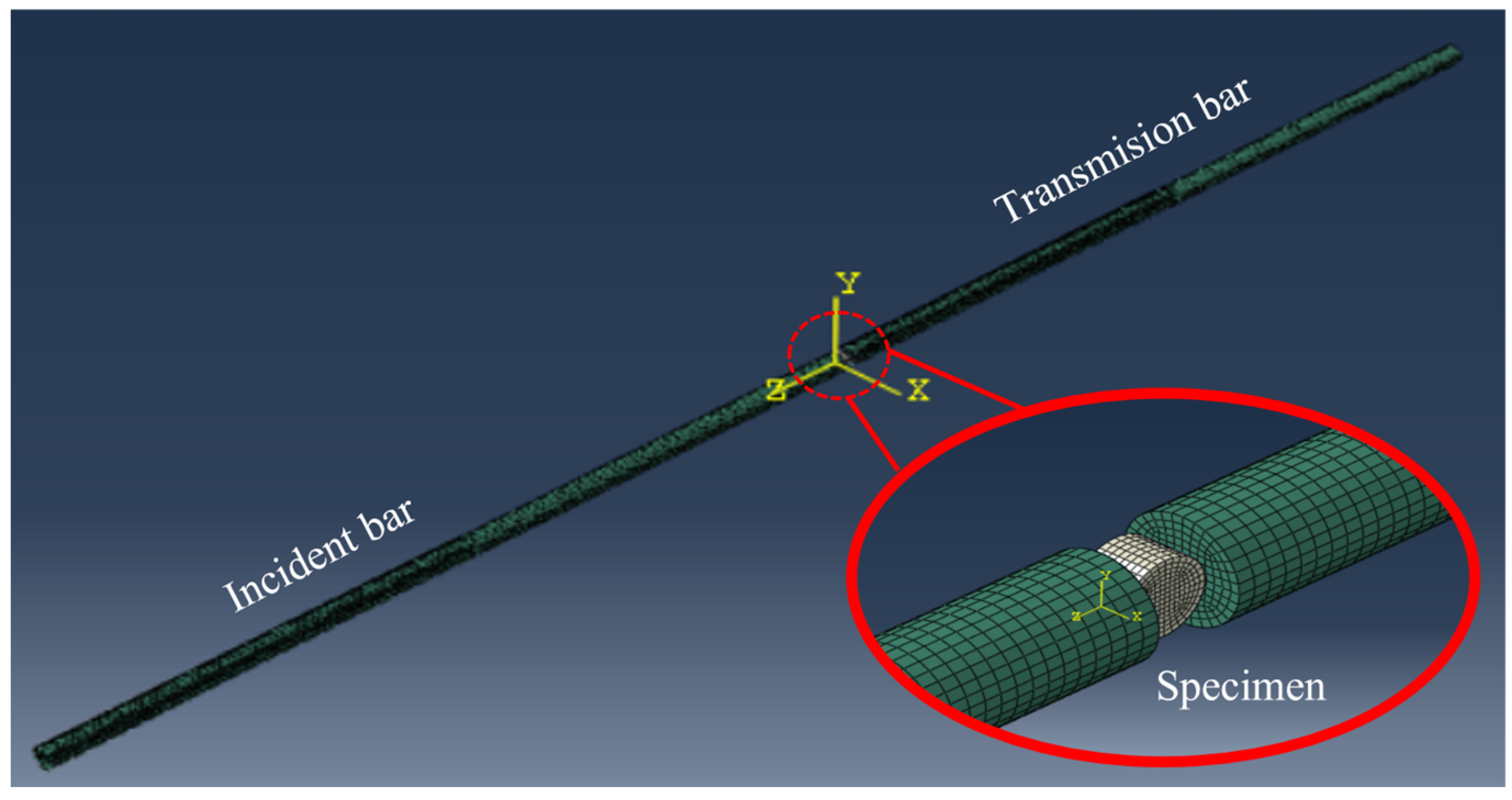
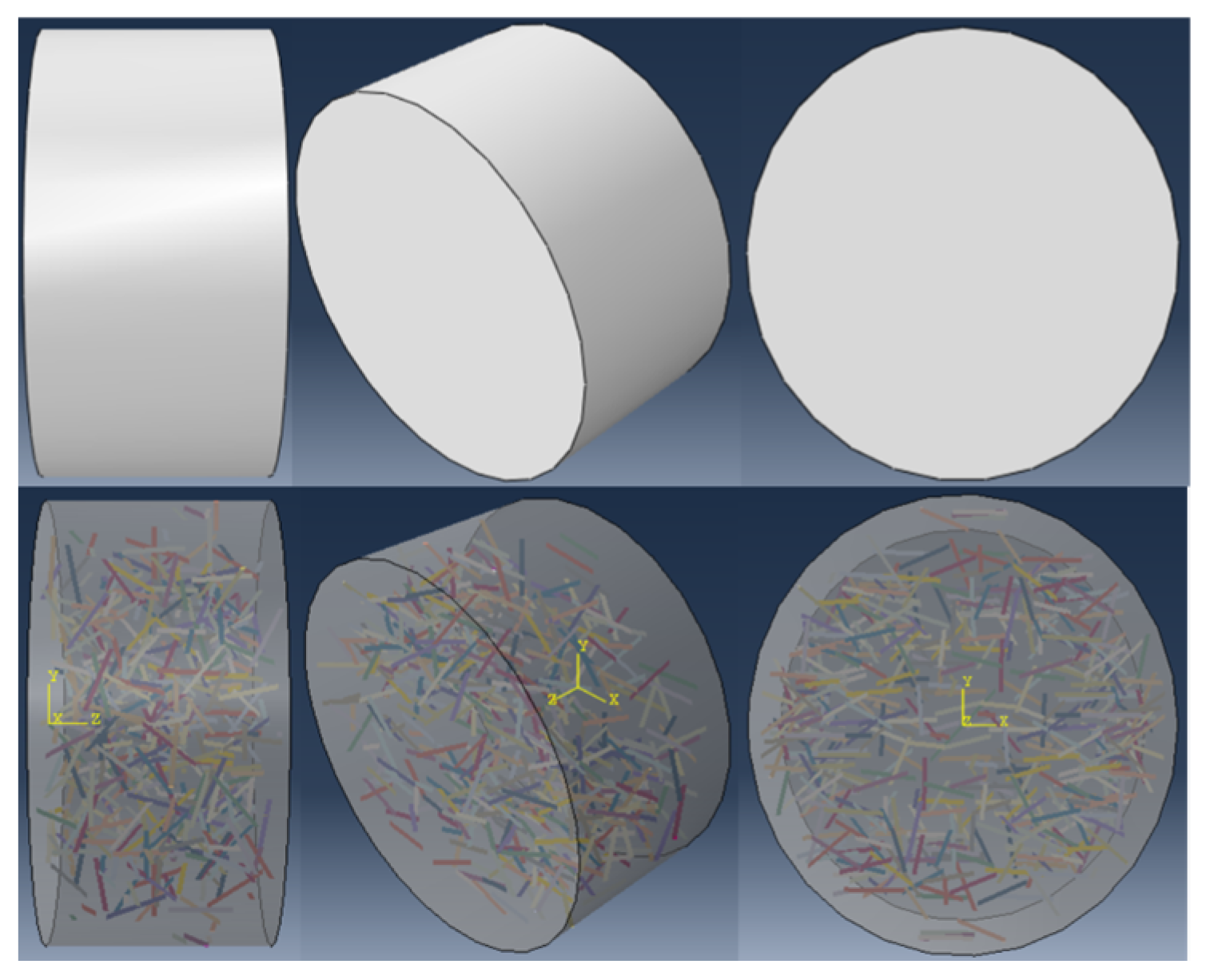
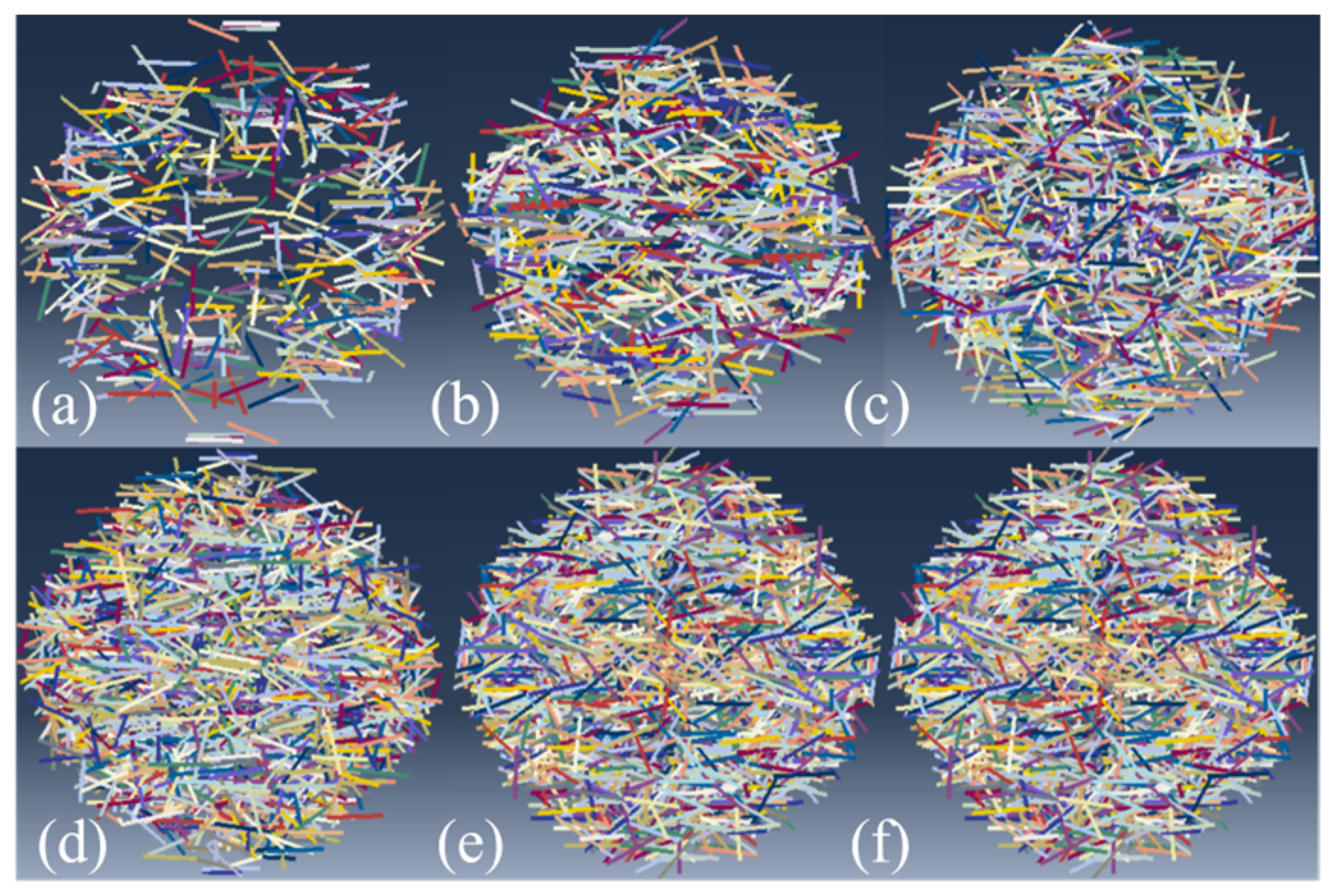


| Types | Cement | Quartz Powder | Sand | Fly Ash | Water Reducer | Water | CPSF |
|---|---|---|---|---|---|---|---|
| CPSF0 | 800 | 260 | 920 | 220 | 16 | 150 | 0 |
| CPSF0.5 | 800 | 260 | 920 | 220 | 16 | 150 | 39 |
| CPSF1 | 800 | 260 | 920 | 220 | 16 | 150 | 78 |
| CPSF1.5 | 800 | 260 | 920 | 220 | 16 | 150 | 117 |
| CPSF2 | 800 | 260 | 920 | 220 | 16 | 150 | 156 |
| CPSF2.5 | 800 | 260 | 920 | 220 | 16 | 150 | 195 |
| CPSF3 | 800 | 260 | 920 | 220 | 16 | 150 | 234 |
| Density (kg/m3) | Elastic Modulus (GPa) | Poisson Ratio |
|---|---|---|
| 7850 | 195 | 0.25 |
| Density (Kg/m3) | Elastic Modulus (GPa) | Poisson Ratio | Kc | Viscosity | Eccentricity | Expansion Angle (°) |
|---|---|---|---|---|---|---|
| 2.366 × 103 | 33.2 | 0.2 | 0.6667 | 0.001 | 0.1 | 35 |
| Density (g/mm3) | Elastic Modulus (GPa) | Poisson Ratio |
|---|---|---|
| 0.0078 | 210 | 0.26 |
Disclaimer/Publisher’s Note: The statements, opinions and data contained in all publications are solely those of the individual author(s) and contributor(s) and not of MDPI and/or the editor(s). MDPI and/or the editor(s) disclaim responsibility for any injury to people or property resulting from any ideas, methods, instructions or products referred to in the content. |
© 2023 by the authors. Licensee MDPI, Basel, Switzerland. This article is an open access article distributed under the terms and conditions of the Creative Commons Attribution (CC BY) license (https://creativecommons.org/licenses/by/4.0/).
Share and Cite
Qi, J.; Liu, A.; Su, P.; Mu, C. Study on Dynamic and Static Mechanical Properties of Copper-Plated Steel-Fiber-Reinforced Self-Compacting Concrete. Materials 2023, 16, 4025. https://doi.org/10.3390/ma16114025
Qi J, Liu A, Su P, Mu C. Study on Dynamic and Static Mechanical Properties of Copper-Plated Steel-Fiber-Reinforced Self-Compacting Concrete. Materials. 2023; 16(11):4025. https://doi.org/10.3390/ma16114025
Chicago/Turabian StyleQi, Juan, Aonan Liu, Peng Su, and Chaomin Mu. 2023. "Study on Dynamic and Static Mechanical Properties of Copper-Plated Steel-Fiber-Reinforced Self-Compacting Concrete" Materials 16, no. 11: 4025. https://doi.org/10.3390/ma16114025






